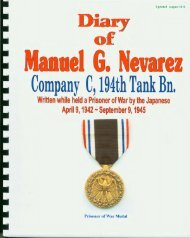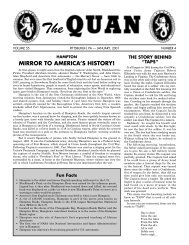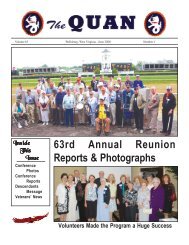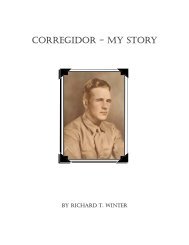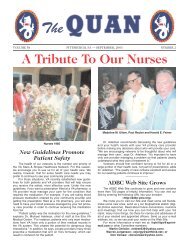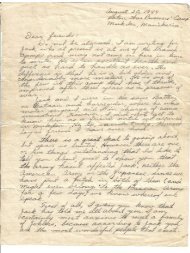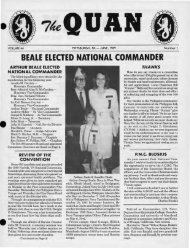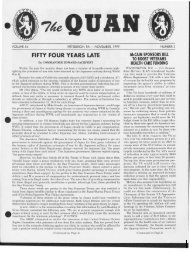June/July 2002 - Philippine Defenders Main
June/July 2002 - Philippine Defenders Main
June/July 2002 - Philippine Defenders Main
Create successful ePaper yourself
Turn your PDF publications into a flip-book with our unique Google optimized e-Paper software.
children, Becky and Jason Bendele, Amy<br />
Rogers, Ellen and Ryan Haffner, Jessie<br />
Kincaid, and great great grandchildren,<br />
Tyler and Hailey Bendele. His parents<br />
and eight brothers preceded him in death.<br />
————————<br />
WARREN H. MELLIES<br />
Warren Harding Mellies, 80, of<br />
Cheyenne died January 20 at the<br />
Veterans Affairs Medical Center.<br />
He was born Oct. 28, 1921, in Adams<br />
City, Colo., and had lived in Cheyenne<br />
since 1960 with prior residence in Casper.<br />
Mr. Mellies retired as a purchasing<br />
agent for the Federal Government after 42<br />
years of service. He served in the U.S.<br />
Marine corps during World War II, and<br />
was a prisoner of war for 31 ⁄2 years.<br />
He was a member of the <strong>Defenders</strong> of<br />
Bataan and Corregidor, the Military<br />
Order of the Purple Heart and Disabled<br />
American Veterans.<br />
Mr. Mellies is survived by his wife,<br />
Christina, whom he married Sept. 17,<br />
1954, in Casper; a son, Warren L. Mellies;<br />
daughters, Linda Ann Conine, and Kimberly<br />
Colling; sister, Betty Lou Matthews;<br />
and six grandchildren.<br />
He was preceded in death by a daughter,<br />
Bertha Marie McCartney; parents,<br />
August and Maude Mellies; sister, Bertha<br />
A. Szymanski; and brothers, Everett B.<br />
Mellies, Ira Mellies, Woodrow W. Mellies,<br />
John W. Mellies and Howard L. Mellies.<br />
Funeral liturgy was at 10 a.m. Wednesday<br />
at Holy Trinity Catholic Church with<br />
the Rev. James Doudican as celebrant.<br />
Interment was in Cheyenne Memorial<br />
Gardens.<br />
————————<br />
STANLEY MROZ<br />
On December 31, 2001 God called another<br />
American hero home — Stanley Mroz,<br />
torpedoman first class, USN. Stanley<br />
enlisted in he U.S. Navy in August of 1938,<br />
and served aboard the original USS<br />
Canopus (AS-9) before being assigned to<br />
submarine duty. Stanley was taken prisoner<br />
by the Japanese on May 6, 1942 when<br />
Corregidor was forced to capitulate.<br />
Unfortunately he spent the next three<br />
years and eight months as a prisoner of<br />
war. Initially, he was held at Bilibid Prison<br />
in Manila, next he was sent to Pasay<br />
School at Nichols Field. His commanding<br />
officer at Nichols Field was the brutal and<br />
sadistic Japanese officer called the “White<br />
Angel.” From Nichols Field Stanley was<br />
sent to northern Japan on the hell ship<br />
Noto Maru (1944). Ultimately he ended up<br />
at Sendai Camp #6 in Hanawa. He was liberated<br />
in January of 1946 and released<br />
from active duty in September of 1946.<br />
Stanley was preceded in death by his<br />
wife Margaret “Eileen” Mroz, and a son,<br />
Daniel Mroz. He is survived by a son Dick<br />
Mroz of Shirley, Indiana, and a daughter<br />
Pat Mroz of Anderson, Indiana. If there<br />
are any sons or daughters of those incarcerated<br />
at Sendai #6 in Hanawa and<br />
8 — THE QUAN<br />
would like to correspond, Dick’s e-mail is<br />
YDMIND@hrtc.net, and Pat’s is PLM-<br />
ROZ20@aol.com.<br />
————————<br />
SHELLEY MYDANS<br />
Shelley Mydans, 86, a journalist who<br />
spent 21 months in a Japanese prisonerof-war<br />
camp during World War II, died<br />
March 7 at her home in New Rochelle,<br />
N.Y. The cause of death was not reported.<br />
She and her husband, photographer<br />
Carl Mydans, were Life magazine’s first<br />
photographer-reporter team to cover the<br />
war, traveling to Europe, China and the<br />
Western Pacific. They were taken prisoner<br />
when Japanese forces arrived in the<br />
<strong>Philippine</strong>s.<br />
Mrs. Mydans, the author of three novels,<br />
was later a commentator for a Time<br />
Inc. radio news program in New York. She<br />
continued to write for Time and Life and<br />
reported from Tokyo when her husband<br />
was bureau chief there.<br />
————————<br />
MICHAEL PULICE<br />
Michael Pulice took the hand of the Lord<br />
and returned home with him on December<br />
8, 2001. He was born February 10, 1919 in<br />
Morencie, Arizona and moved to Carlsbad,<br />
New Mexico in 1931 with his mother,<br />
father, two sisters and younger brother. He<br />
was a volunteer member of the 200th Coast<br />
Artillery, a NM National Guard Regiment<br />
and was inducted into active military service<br />
in 1941. He was wounded in action at<br />
Clark Air Field, Bataan, <strong>Philippine</strong>s on<br />
April 2, 1942 and taken prisoner. On<br />
September 7, 1944 the Japanese POW ship,<br />
Shinyo Maru, carrying over 800 prisoners<br />
was torpedoed by an American submarine<br />
resulting in only 83 survivors. He was rescued<br />
by <strong>Philippine</strong> guerrillas after swimming<br />
in shark infested waters for over 24<br />
hours with a severe leg injury. He returned<br />
to the United States as a patient at Walter<br />
Reed Army Medical Center, Washington,<br />
D.C. in December 1944 after 2 1 ⁄2 years as a<br />
POW. Mike returned to Manila in 1946 and<br />
provided personal testimony at the war<br />
crimes trials. He was given the honor as the<br />
designated US Army representative who<br />
accepted the 1st three cent Bataan memorial<br />
postage stamp presented by President<br />
Harry S. Truman. Mike was a highly decorated<br />
WWII veteran receiving numerous<br />
awards including the Purple Heart and discharged<br />
from the Army in September 1948.<br />
He attended Loyola University in Los<br />
Angeles, CA and received his degree in<br />
1953. He retired from a successful 30 year<br />
career as a New Mexico state employee in<br />
Santa Fe, NM. He was an Honorary life<br />
time member of the BPOE, the American<br />
Legion, the DAV, Order of the Purple Heart<br />
and the VFW. He had been a resident of<br />
Las Cruces for over 20 years.<br />
He is survived by his wife Mary<br />
Heathman Pulice and her 4 adult children<br />
and grandchildren; daughter, Helen Marie<br />
Griego and her husband Joseph Griego;<br />
son Michael W. Pulice and his wife<br />
Patricia; three grandchildren, Daren Choi<br />
and her husband Chin, Sarah and Michael<br />
F. Pulice and one great-granddaughter,<br />
Catherine Celeste Choi; 2 sisters, Olympia<br />
West and Mary Louise Lyle and her husband,<br />
Ken and youngest brother Alric<br />
Pulice from Texas.<br />
————————<br />
NOEL RAVNEBERG<br />
“I can’t believe what went on today. I’m<br />
still in wonderment at the outgoing<br />
expressed by everyone,” said Noel M.<br />
Ravneberg, after Gen. John Abrams of<br />
Fort Monroe presented him with a Purple<br />
Heart in recognition of the years he’d<br />
spent as a prisoner of war during World<br />
War II. The ceremony was held at the<br />
Training & Doctrine Command on April 9,<br />
<strong>2002</strong>, 60 years to the day of his capture by<br />
the Japanese. The crowd gave him four<br />
prolonged ovations.<br />
Mr. Ravneberg of Ford’s Colony, a survivor<br />
of the Bataan Death March, died May<br />
18 at Williamsburg Community Hospital.<br />
He was born in Devils Lake, N.D., on<br />
Nov. 19, 1916. In March 1941 he entered<br />
the Army, and in September he was<br />
shipped to the <strong>Philippine</strong> Islands with the<br />
194th Tank Battalion, a National Guard<br />
Unit. He was a halftrack operator with a<br />
crew of four.<br />
When the Japanese landed on the<br />
Bataan Peninsula, the men from the<br />
194th and other units held out until April<br />
9, 1942. Maj. Gen. E.P. King, commander<br />
of Bataan, surrendered after the defenders<br />
had been on half rations for two<br />
months. In addition, they were running<br />
low on ammunition.<br />
Upon the fall of Bataan to the Japanese,<br />
Cpl. Ravneberg was taken prisoner and<br />
endured the infamous Death March, considered<br />
the greatest surrender in U.S. military<br />
history. Some 70,000 American and<br />
<strong>Philippine</strong> soldiers were forced to march<br />
60 to 70 miles across the island, with no<br />
food and no water. An estimated 21,000<br />
men died. He was a prisoner of the<br />
Japanese for 3 1 ⁄2 years.<br />
When World War II ended, the only way<br />
the prisoners knew it was over was that<br />
the guards suddenly vanished. After<br />
release from the prison, Mr. Ravneberg<br />
weighed 85 pounds and was barely able to<br />
walk. He spent a long time in Army hospitals<br />
recovering from malaria, the beatings<br />
he’d received and amoebic dysentery.<br />
He moved to Queens, N.Y., where he<br />
made watches for the Bulova Watch Co. In<br />
the evenings, he attended Columbia University<br />
and earned a bachelor’s degree in<br />
geology. In 1954, he earned his master’s<br />
degree.<br />
His first job was with the state of New<br />
York. He soon signed on with a company<br />
that did foundation engineering around<br />
the world. Mr. Ravneberg traveled to<br />
South America, Panama, Morocco, Egypt,<br />
Borneo, Portugal, Iceland and half of the



